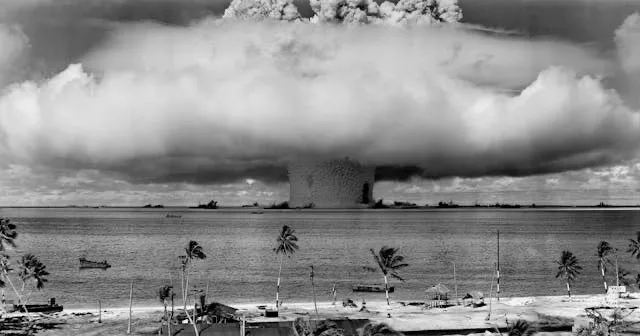Few developments have shaped South Asia’s security landscape as profoundly as Pakistan’s decision to develop nuclear weapons. Unlike the early nuclear powers, whose programs emerged during or shortly after World War II, Pakistan’s path unfolded later and under very different conditions—marked by regional rivalries, shifting alliances, and repeated military conflict. The program took shape in the aftermath of India’s first nuclear test in 1974, which altered the regional balance and prompted Pakistan’s leadership to view a nuclear deterrent as a strategic necessity. What followed was a decades-long effort that combined domestic research, covert procurement, and sustained political and military backing—carried out largely outside public view. This article traces the origins of Pakistan’s nuclear program, the reasons behind its pursuit, and the methods used to bring it to fruition. It also explores the broader context in which these decisions were made, offering a clearer picture of how Pakistan became one of the world’s recognized nuclear-armed states.
The Basics: How Nuclear Weapons Work
Fission vs. Fusion
Nuclear weapons derive their explosive energy from two types of reactions: fission and fusion. Fission weapons, often called atomic bombs, split heavy atomic nuclei like uranium-235 or plutonium-239. The Hiroshima and Nagasaki bombs were fission-based and produced explosive yields equivalent to 15 and 21 kilotons of TNT, respectively. Fusion weapons, also known as thermonuclear or hydrogen bombs, fuse light nuclei like deuterium and tritium to release much greater energy. These are multi-stage devices, often with yields measured in megaton ranges—millions of tons of TNT. Fusion weapons are far more powerful and destructive than fission bombs, and they dominate the arsenals of modern nuclear powers.
Measured in Kilotons and Megatons
The power of a nuclear bomb is typically measured in kilotons (kt) or megatons (Mt) of TNT equivalent. One kiloton equals the explosive power of 1,000 tons of TNT. For context:
- The Hiroshima bomb = ~15 kilotons
- The largest bomb ever tested (Tsar Bomba by the USSR) = 50 megatons
That means Tsar Bomba was over 3,000 times more powerful than the Hiroshima bomb.
Immediate Effects of a Nuclear Explosion
The power of a nuclear weapon is not just in its explosive yield—it lies in the multiple overlapping effects it unleashes.
1. Blast Wave
The initial explosion produces a shockwave that flattens buildings, throws vehicles, and kills people within several kilometers of ground zero. For a 1-megaton bomb:
- Total destruction radius: ~2–3 km
- Severe damage radius: ~6–8 km
- Windows shatter: ~20+ km away
Pressure from the blast can exceed 20 psi near the epicenter—enough to destroy reinforced concrete structures.
2. Thermal Radiation
Temperatures at the point of detonation can reach millions of degrees Celsius, creating a fireball that causes severe burns, fires, and blindness. At close range, human skin can suffer third-degree burns within seconds. The heat from a single bomb can ignite firestorms, like those seen in Hiroshima, consuming large portions of cities.
3. Ionizing Radiation
Nuclear weapons emit intense radiation—gamma rays, neutrons, and alpha/beta particles. This causes acute radiation sickness, DNA damage, and long-term cancer risks. Radiation is most dangerous:
- Within the first minute after detonation (prompt radiation)
- For days to weeks afterward (fallout radiation)
4. Electromagnetic Pulse (EMP)
High-altitude nuclear explosions can generate a powerful EMP capable of disabling electronic equipment over a wide area—potentially an entire continent depending on altitude and yield. This can disrupt:
- Power grids
- Communication systems
- Civil and military infrastructure
5. Radioactive Fallout
If the bomb is detonated at or near the surface, it kicks up massive amounts of radioactive debris. Fallout particles are carried by the wind and can spread across hundreds or thousands of kilometers, contaminating soil, water, and food. Fallout can remain dangerous for weeks to decades, depending on the isotopes involved.
Comparative Power: Conventional vs. Nuclear Weapons
To understand the scale of a nuclear weapon, it’s helpful to compare it with conventional explosives:
| Weapon Type | Explosive Power | |————–|———————–| | 2,000 lb bomb| ~1 ton of TNT | | MOAB (U.S. largest) | ~11 tons of TNT | | Hiroshima Bomb | ~15,000 tons of TNT | | Modern H-bomb | ~1–2 million tons of TNT | | Tsar Bomba | ~50 million tons of TNT |
The Hiroshima bomb alone was more powerful than the combined total of all bombs dropped in World War II, excluding the other nuclear bomb.
Tactical vs. Strategic Nuclear Weapons
Not all nuclear weapons are designed to flatten cities.
Tactical Nuclear Weapons
These are low-yield devices (under 10 kt) designed for battlefield use:
- Targets: military bases, troop concentrations, airfields
- Yield: often under 5 kilotons
- Range: delivered by artillery, cruise missiles, or short-range missiles
Though smaller, they still cause mass casualties and would represent a major escalation if used.
Strategic Nuclear Weapons
Designed for large-scale deterrence:
- Targets: cities, industrial centers, missile silos
- Yield: often 100 kt to several megatons
- Delivery: ICBMs, SLBMs, strategic bombers
These are the cornerstone of mutually assured destruction (MAD) doctrines between major powers.
The Psychological and Political Power
Beyond physical destruction, nuclear weapons wield enormous psychological and political influence:
- Deterrence: The mere possession of nuclear weapons deters invasion or regime change.
- Diplomatic Leverage: Nuclear states often enjoy more weight in international negotiations.
- Geostrategic Status: Possession often signals a country’s advanced technological and military status.
Even countries with small arsenals, like North Korea or Israel, can deter much larger adversaries.
How Many Nuclear Weapons Exist Today?
As of 2024, these are the approximate global stockpile numbers:
| Country | Estimated Warheads | |—————–|——————–| | Russia | ~5,889 | | United States | ~5,244 | | China | ~500+ | | France | ~290 | | United Kingdom | ~225 | | Pakistan | ~170 | | India | ~170 | | Israel | ~90 | | North Korea | ~40–50 |
While these numbers are down from Cold War highs, the total destructive power is still more than enough to end life on Earth as we know it.
Are Modern Nuclear Weapons More Powerful?
In many ways, yes—and no.
- Yes, in terms of accuracy, miniaturization, and flexibility.
- No, in that the largest bombs ever tested (like Tsar Bomba) are generally considered impractical due to their destructive overkill.
Modern weapons focus more on precision and survivability, with multiple independently targetable reentry vehicles (MIRVs) and hardened silos or submarine deployment.
The Evolution of Nuclear Strategy
The evolution of nuclear strategy has been significant since the first atomic bombs were dropped. Initially, the focus was on sheer destructive power. However, as nations developed second-strike capabilities, the emphasis shifted towards deterrence and survivability. For instance, the deployment of nuclear submarines ensures that a country can retaliate even if its land-based arsenals are destroyed.
Second-Strike Capability
A vital aspect of modern nuclear strategy is maintaining a credible second-strike capability. This involves ensuring that a country can respond to a nuclear attack with its own nuclear arsenal, deterring adversaries from launching a first strike. Submarine-launched ballistic missiles (SLBMs) play a crucial role here, as they can remain hidden in the oceans and are less vulnerable to a pre-emptive attack.
The Role of Technology
Advancements in technology have also changed nuclear strategies. For example, the development of missile defense systems has introduced new dynamics into the equation. While these systems aim to protect against incoming missiles, they also complicate the strategic calculus, as adversaries may feel pressured to increase their arsenals to overwhelm defenses.
What Would a Modern Nuclear War Look Like?
No one can say with certainty, but estimates based on models suggest:
- Millions of immediate deaths, even with limited exchanges
- Collapse of infrastructure and healthcare
- Global economic shock
- Nuclear winter scenarios from firestorms and soot in the atmosphere, leading to mass famine
Even a “small” regional nuclear war—say, between India and Pakistan—could disrupt global climate and food systems for years.
Humanitarian Impact
The humanitarian impact of nuclear war is staggering. Beyond the immediate loss of life, survivors would face severe challenges. Infrastructure collapse would mean shortages of food, clean water, and medical supplies, exacerbating the crisis. The psychological trauma of survivors would also be immense, with long-term impacts on mental health.
Environmental Consequences
Nuclear war would also have devastating environmental consequences. The release of soot and debris into the atmosphere could block sunlight, leading to a dramatic drop in temperatures—a phenomenon known as “nuclear winter.” This could disrupt global agriculture, leading to food shortages and mass starvation.
Lessons from History
The history of nuclear weapons is replete with near-misses and lessons that continue to shape policy today. One such incident was the Cuban Missile Crisis of 1962, which brought the world to the brink of nuclear war. The crisis highlighted the dangers of miscommunication and the importance of diplomacy in resolving nuclear standoffs.
The Role of Diplomacy
Diplomacy plays a crucial role in managing nuclear threats. Treaties such as the Non-Proliferation Treaty (NPT) and the Strategic Arms Reduction Treaty (START) have been instrumental in reducing global arsenals and preventing the spread of nuclear weapons. Ongoing dialogue and negotiation are essential to maintaining these agreements and preventing escalation.
The Future of Nuclear Weapons
As we look to the future, the role of nuclear weapons in global security remains a topic of intense debate. While some argue for total disarmament, others believe that nuclear deterrence is necessary to maintain peace. The challenge lies in balancing these perspectives while ensuring that policies reflect the realities of a rapidly changing world.
The Path to Disarmament
Achieving nuclear disarmament is a complex and challenging goal. It requires the cooperation of nuclear-armed states and a robust verification regime to ensure compliance. Confidence-building measures, such as transparency in arsenals and the reduction of stockpiles, are crucial steps toward this end.
Emerging Threats
New threats are also emerging that could impact nuclear strategy. Cybersecurity threats, for example, pose a risk to the command and control systems of nuclear arsenals. Ensuring the integrity of these systems is critical to preventing unauthorized launches or accidents.
Nuclear weapons are powerful in every sense of the word. Physically, they are capable of leveling entire cities in seconds. Strategically, they reshape global relationships and military doctrines. Politically, they influence negotiations, alliances, and national identities. Their power lies not just in their destructive capability, but in their ability to prevent wars, trigger arms races, shape diplomacy, and haunt the decisions of world leaders. Despite their age, nuclear weapons remain as relevant—and as dangerous—as ever. Their power is not just a relic of the past, but a defining feature of the present and the future.




